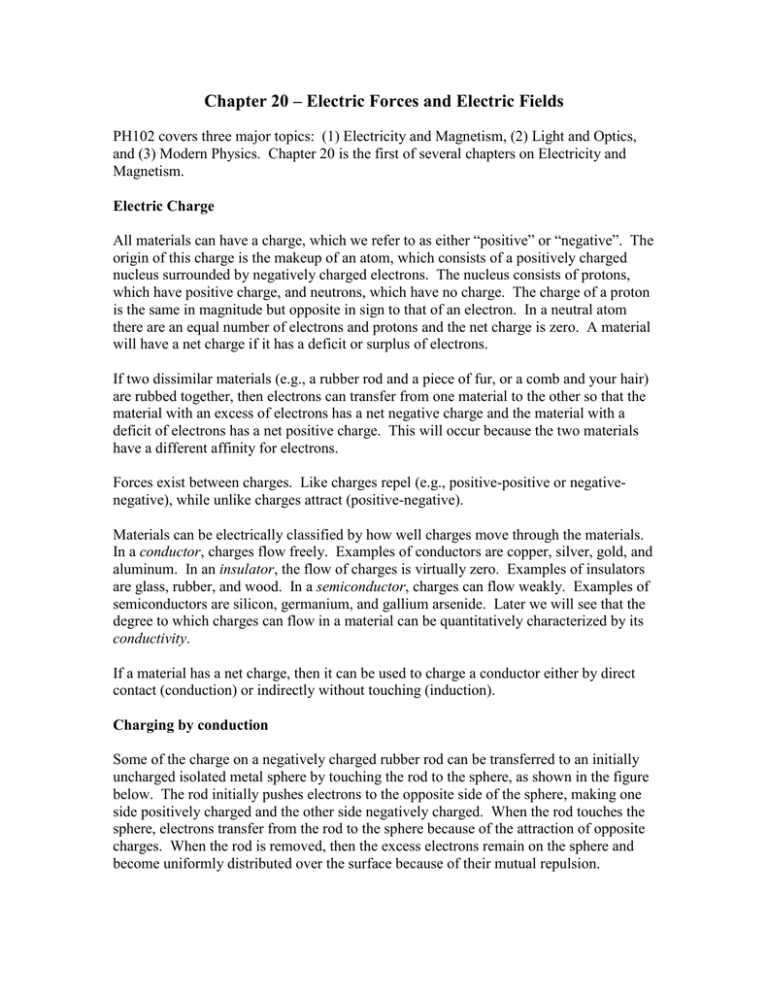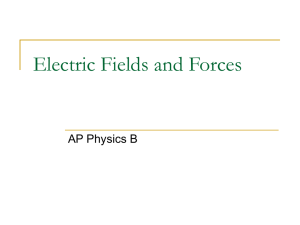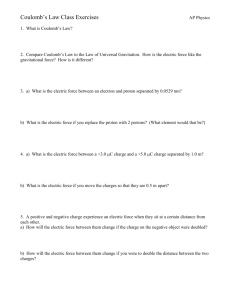CH20-Electric Fields..
advertisement

Chapter 20 – Electric Forces and Electric Fields PH102 covers three major topics: (1) Electricity and Magnetism, (2) Light and Optics, and (3) Modern Physics. Chapter 20 is the first of several chapters on Electricity and Magnetism. Electric Charge All materials can have a charge, which we refer to as either “positive” or “negative”. The origin of this charge is the makeup of an atom, which consists of a positively charged nucleus surrounded by negatively charged electrons. The nucleus consists of protons, which have positive charge, and neutrons, which have no charge. The charge of a proton is the same in magnitude but opposite in sign to that of an electron. In a neutral atom there are an equal number of electrons and protons and the net charge is zero. A material will have a net charge if it has a deficit or surplus of electrons. If two dissimilar materials (e.g., a rubber rod and a piece of fur, or a comb and your hair) are rubbed together, then electrons can transfer from one material to the other so that the material with an excess of electrons has a net negative charge and the material with a deficit of electrons has a net positive charge. This will occur because the two materials have a different affinity for electrons. Forces exist between charges. Like charges repel (e.g., positive-positive or negativenegative), while unlike charges attract (positive-negative). Materials can be electrically classified by how well charges move through the materials. In a conductor, charges flow freely. Examples of conductors are copper, silver, gold, and aluminum. In an insulator, the flow of charges is virtually zero. Examples of insulators are glass, rubber, and wood. In a semiconductor, charges can flow weakly. Examples of semiconductors are silicon, germanium, and gallium arsenide. Later we will see that the degree to which charges can flow in a material can be quantitatively characterized by its conductivity. If a material has a net charge, then it can be used to charge a conductor either by direct contact (conduction) or indirectly without touching (induction). Charging by conduction Some of the charge on a negatively charged rubber rod can be transferred to an initially uncharged isolated metal sphere by touching the rod to the sphere, as shown in the figure below. The rod initially pushes electrons to the opposite side of the sphere, making one side positively charged and the other side negatively charged. When the rod touches the sphere, electrons transfer from the rod to the sphere because of the attraction of opposite charges. When the rod is removed, then the excess electrons remain on the sphere and become uniformly distributed over the surface because of their mutual repulsion. Before contact Contact After contact Charging by induction A positive charge can be induced onto the metal sphere without bringing the negatively charged rod into contact with the sphere. Instead, a conducting wire connects the sphere to a ‘ground’ (e.g., a copper pipe buried in the earth). This ‘ground’ provides an infinite reservoir of electrons to flow to or from the conducting sphere. Before grounding After grounding After removing ground After removing rod Coulomb’s Law The force between two point charges is given by Coulomb’s law: qq F ke 1 2 r2 q1 and q2 are the charges and r is the distance between the charges. ke is the Coulomb constant and is given in the SI system by k e 8.99 x10 9 N m 2 / C 2 The SI unit for charge is the coulomb (C). The smallest unit of charge is that of the electron or proton. The magnitude of the electronic charge is e 1.60 x10 19 C . The charge of the proton is qp = e and the charge of the electron is qe = -e. All charges are integral multiples of e. In Coulomb’s law F is positive and repulsive if q1 and q2 have the same sign and is negative and attractive if q1 and q2 have the opposite signs. Coulomb’s law is mathematically very similar to the universal law of gravitation between two point masses, which is mm F G 1 2 r2 where G is the universal gravitation constant. Both forces are proportional to the product of the charges or masses and inversely proportional to their separation. The gravitational force, however, is always attractive (there are no negative masses); whereas, the electrical force can be attractive or repulsive. Example: Compare the magnitude of the electrical and gravitational forces between the electron and proton in the hydrogen atom. Given: me = 9.11 x 10-31 kg, mp = 1.67 x 10-27 kg, r = 5.3 x 10-11 m. Fe k e Fg G | qe q p | r 2 r ( 1.6 x10 19 C )2 ( 5.3x10 m p me 2 ( 8.99 x10 9 N m 2 / C 2 ) ( 6.67 x10 11 2 2 N m / kg ) 11 m) 8.19 x10 8 N 2 ( 1.67 x10 27 kg )( 9.11x10 31 kg ) ( 5.3x10 11 m) 2 3.61x10 47 N Fe 8.19 x10 8 N 2.27 x10 39 47 Fg 3.61x10 N The electrical forces in an atom are so large compared to the gravitational forces that the gravitational forces can be completely neglected. When considering ordinary masses, gravity is much more important since the net charge on the masses is relatively small. Example: Find the force on the charge q2 in the diagram below due to the charges q1 and q2. q1 = 1 µC q2 = -2 µC 0.1 m F12 ke | q1 || q2 | F32 ke | q3 || q2 | r122 r322 q3 = 3 µC 0.15 m ( 8.99 x109 N m 2 / C 2 ) 9 2 2 ( 1x106 C )( 2 x106 C ) ( 8.99 x10 N m / C ) ( 0.1m )2 1.8 N ( to the left ) ( 3 x106 C )( 2 x106 C ) ( 0.15m )2 F2 F12 F32 1.8 N 2.4 N 0.6 N ( to the right ) 2.4 N ( to the right ) Example: Find the force on q2 in the diagram to the right. q3 = 3 µC Fx F12 1.8 N F y F32 2.4 N 0.15 m F2 Fx2 F y2 ( 1.8 ) 2 ( 2.4 ) 2 3.0 N tan Fy Fx 2.4 1.33 1.8 q1 = 1 µC q2 = -2 µC 0.1 m 126.9 o ( ccw from pos . x axis ) q3 = 3 µC F2 q1 = 1 µC F32 F12 q2 = -2 µC Electric Field The electric field is a concept that helps to visualize the fact that charges can exert forces on each other without being in contact. A charge can be thought of as producing an electric field in the space surrounding the charge analogous to the gravitational field due to a mass. This electric field can then exert a force on another charge. To determine the electric field, E, due to a charge Q, we imagine a small test charge q0 placed at a point relative to Q. Then E is defined as the force on q0 divided by q0. E F q0 (units are N/C) The direction of E is the same as the direction of F on a positive test charge. If we know E we can find the force on any charge q from F qE Electric field due to a point charge From Coulomb’s law, the magnitude of the force on a test charge q0 do to a point charge q is F ke | q || q0 | r2 . Thus, the magnitude of the electric field due to q is E ke |q| r2 . The direction of E is radially away from positive charges and radially toward negative charges. E is analogous to the gravitational field g due to a mass. For example, for a point mass M, g G M r2 . Knowing g, we can find the force on a mass m from F = mg. The gravitational field due a mass M always points towards M. Example: q2 = -1.5 µC Find the electric field at P due to charges q1 and q2. E1 k e | q1 | E2 k e | q2 | r12 r22 9 ( 8.99 x10 ) ( 2 x10 6 ) ( 8.99 x10 9 ) ( 0.4 )2 1.13x10 5 N / C ( 1.5 x10 6 ) ( 0.5 ) 2 0.3 m 5.4 x10 4 N / C q1 = 2 µC P 0.4 m E x E1 E 2 cos 1.13x10 5 5.4 x10 4 cos( 36.9 ) q2 = -1.5 µC 6.9 x10 4 N / C E y E 2 sin 5.4 x10 4 sin( 36.9 ) 3.24 x10 4 N / C 0.3 m 0.5 m E2 E E x2 E y2 ( 6.9 x10 4 )2 ( 3.24 x10 4 )2 7.6 x10 4 N / C 1 1 tan ( E y / E x ) tan ( 3.24 / 6.9 ) 25 o E = 36.9 o q1 = 2 µC 0.4 m P E1 Electric Field Lines The strength and direction of the electric field can be graphically displayed using electric field lines. These are lines that originate on positive charges and terminate on negative charges. The number of lines originating or terminating on a charge is proportional to the magnitude of the charge. The direction of the electric field is the direction of the tangent to a line and the strength of the electric field is proportional to the density of lines. The field lines for a positive point charge and a negative point charge are shown below. If a positive and a negative charge are brought close together, then the field lines are a superposition of the field lines for the separate charges. Likewise, for two equal positive charges which are close together: Conductors in Equilibrium Consider an isolated conductor, such as copper, silver or gold, in which the charges are in equilibrium. (No batteries, for example, to drive a current through the conductor.) The conductor will have the following properties: 1. E = 0 everywhere inside the conductor. 2. Any excess charge will reside on the surface. 3. E just outside the conductor will be perpendicular to the surface. We consider each property separately. 1. E (inside) = 0. Conductors have electrons that can freely move under the influence of an electric field. If E (inside) were not zero, then there would be currents inside. However, we are considering the properties of conductors in electrostatic equilibrium. 2. Excess charge resides on surface(s). Since like charges repel, if there were excess charge inside, then the repulsive forces on these charges would push them as far apart from each other as possible, which would mean to the surface. The binding force of the electron to the metal would keep them at the surface (unless the charge was so great that the electrostatic repulsion would overcome the binding force and the charge would ‘arc’ to another object.) 3. If E is perpendicular to the surface, then E (parallel) = 0. If E (parallel) were not zero, then there would surface currents. Again, we are assuming that the charges are in equilibrium. It is also true that charge concentrates more on the surface regions which have the greater curvature. Consequently, the electric field is greater at these sharp regions. The curvature reduces the component of the repulsive force between charges that is tangent to the surface, which allows the charges to be closer together. Because the electric field is greater near sharp points, these are the places where the charge is most likely to arc if the charge on the conductor becomes too great. Electric Dipole A positive-negative charge pair whose charges have equal magnitudes is referred to as an electric dipole (or electric dipole moment). A dipole generates an electric field which is the sum of the electric fields of the positive and negative charges, as shown below. The dipole moment is defined as the charge times the separation of the charges, p qd [units = C∙m] The direction of the dipole moment is from the negative to the positive charge. A point dipole refers to a charge pair for which the separation is very small. A water molecule, for example, looks like a point dipole for distances far from the molecule. Although the net charge of the molecule is zero, it has more positive charge on one end and more negative charge on the other end. p If a dipole moment is placed in an electric field (due to some other charges), then it will experience a torque that will try to align it in the direction of the external field. F = qE p d -F The torque about the midpoint of the charges is given as F d d sin F sin Fd sin qEd sin 2 2 Or, pE sin Motion of a charge in a uniform electric field In a uniform electric field, a charge undergoes an acceleration given by a F qE m m Example: An electron is released from rest in a uniform electric field E = 1000 N/C. How long does it take the electron to travel a distance of 2 cm? Solution: x 1 at 2 , 2 a t qE ( 1.6 x10 19 C )( 1000 N / C ) 1.76 x1014 m / s 2 31 m 9.11x10 kg 2x 2( 0.02m ) 1.51x10 8 s 14 2 a 1.76 x10 m / s How fast is the electron going after 2 cm? Solution: v at ( 1.76 x1014 m / s 2 )( 1.51x10 8 s ) 2.66 x10 6 m / s Cathode Ray Tube In a cathode ray tube (e.g., oscilloscopes and older computer monitors) electrons are accelerated toward a screen and are deflected left-right or up-down by an electric field. A uniform electric field can be generated between two oppositely charged metal plates if the lateral size of the plates is large compared to their separation. It can be shown that the field is given by E Q 0 A , where Q is the charge on a plate, A is the area of the plates, and 0 8.85 x10 12 C 2 /( N m 2 ) The motion of the electron is analogous to the motion of a projectile in a gravitational field. E v F F F E electron gun deflection plates






